On a remote peninsular in the Arctic circle, enormous wounds are appearing in the permafrost – as something that is worrying scientists bursts out from underground.I
It appeared suddenly and explosively, leaving a ragged pockmark on the landscape.
Around the crater’s edge, the earth is a torn, grey jumble of ice and clods of permafrost. The roots of plants – newly exposed around the rim – show signs of scorching. It gives some idea of just how violently this hole in the middle of the Siberian Arctic materialised.
From the air, the freshly exposed dirt stands out against the green tundra and dark lakes around it. The layers of earth and rock exposed further inside the cylindrical hole are almost black and a pool of water is already forming at the bottom by the time scientists reach it.
Among them is Evgeny Chuvilin, a geologist at the Skolkovo Institute of Science and Technology, based in Moscow, Russia, who has flown out to this remote corner of the Yamal Peninsula in north-west Siberia to take a look. This 164-foot-deep (50m) hole could hold key parts of a puzzle that has been bothering him for the past six years since the first of these mysterious holes was discovered elsewhere on the Yamal Peninsula.
That hole, which was around 66ft (20m) wide and up to 171ft (52m) deep, was discovered by helicopter pilots passing overhead in 2014, around 26 miles (42km) from the Bovanenkovo gas field on the Yamal Peninsula. The scientists who visited it – including Mariana Leibman, chief scientist of the Earth Cryosphere Institute, who has been studying the permafrost in Siberia for more than 40 years – described it as an entirely new feature in permafrost. Analysis of satellite images later revealed that crater – now known as GEC-1 – formed sometime between 9 October and 1 November 2013.
The latest crater was spotted in August this year by a TV crew as they flew past with a team of scientists from the Russian Academy of Sciences during an expedition with local authorities in Yamal. It brings the total number of confirmed craters to have been discovered on Yamal and the neighbouring Gydan Peninsula to 17.
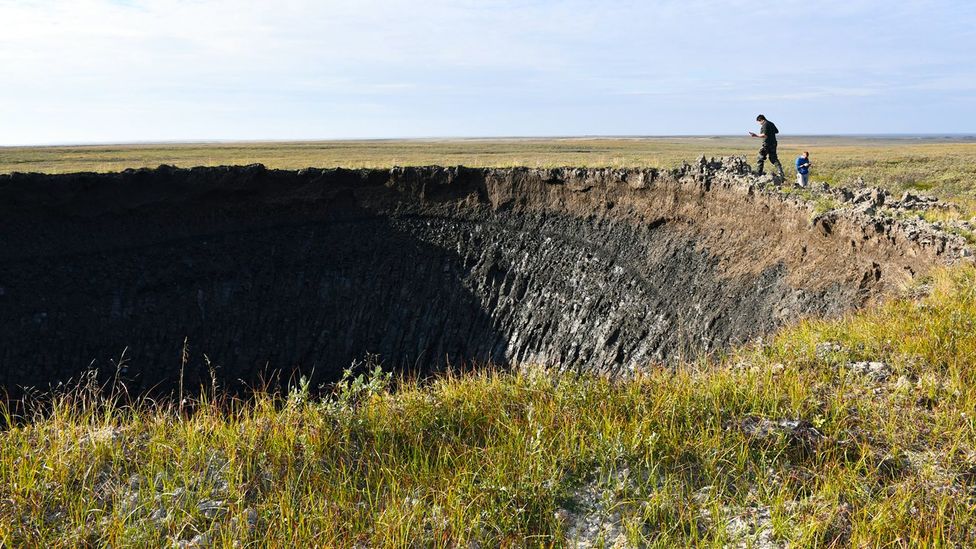
Scientists at the Russian Academy of Sciences’ Institute of Oil and Gas Problems visited the newest crater during an expedition to Yamal in August 2020 (Credit: Evgeny Chuvilin)
But exactly what is causing these enormous holes in the permafrost to appear and how suddenly they form is still largely a riddle. There are also unanswered questions about what they mean for the future of the Arctic, along with the people who live and work there. For many of those who study the Arctic, they are a disquieting sign that this cold, largely unpopulated landscape at the north of our planet is undergoing some radical changes.
Recent research, however, is now starting to provide some clues about what might be going on. What is clear is that these holes are not forming due to some gradual subsidence as the permafrost melts and shifts below the surface. They explode into being.
“As the blast occurs, blocks of soil and ice are thrown hundreds of metres from the epicenter,” says Chuvilin. “We are faced here with a colossal force, created by very high pressure. Why it is so high still remains a mystery.”
Chuvilin is one of a group of Russian scientists – collaborating with colleagues from around the world – who have been visiting these craters to take samples and measurements in the hope of understanding more about what is going on beneath the tundra.
Some scientists have compared the craters to cryovolcanoes – volcanoes that spew ice instead of lava – thought to exist in some of the distant parts of our solar system on Pluto, Saturn’s moon Titan and the dwarf planet Ceres. But as more Arctic craters have been studied in various stages of their evolution, they have become known as “gas emission craters”. The name gives some clue to how they are thought to form.
“Analysis based on satellite imagery shows that a blast makes a giant hole in the place of a pingo, or mound,” says Chuvilin. Pingos are dome-shaped hills that form when a layer of frozen ground is pushed up by water that has managed to flow underneath it and started to freeze. As the water freezes, it expands to create a mound. Also known in Russia by the local Yakut name “bulgunnyakhs”, they tend to rise and fall with the seasons. Some in Canada have been found to be up to 1,200 years old. In most parts of the Arctic, however, these mounds tend to eventually collapse in on themselves rather than explode.
There is evidence that the life cycle of gas emission crater can be very short, ranging from 3-5 years – Alexander Kizyakov
It is clear that the mounds in north-west Siberia are behaving differently. They swell “very fast, rising to several metres” before they blow their top suddenly, explains Chuvilin. And instead of freezing water, the uplift appears to be caused by a build-up of gas beneath the ground.
“Pingos take decades to form and last a long time,” says Sue Natali, an Arctic ecologist who studies permafrost and director of the Arctic programme at the Woodwell Climate Research Center in Woods Hole, Massachusetts. “These gas-filled mounds form in the order of years.”
One study of tree rings in willow shrubs found among the debris thrown out by the explosion that created the first crater discovered in 2014 suggests the plants had been experiencing stress since the 1940s. The researchers say this could have been due to deformation of the ground.
“However, there is evidence that the life cycle of gas emission craters can be very short, ranging from 3-5 years,” says Alexander Kizyakov, a cryolithologist at Lomonosov Moscow State University in Russia. One crater that formed in the early summer of 2017, known as SeYkhGEC, was found in satellite images to have first begun deforming the ground in 2015.
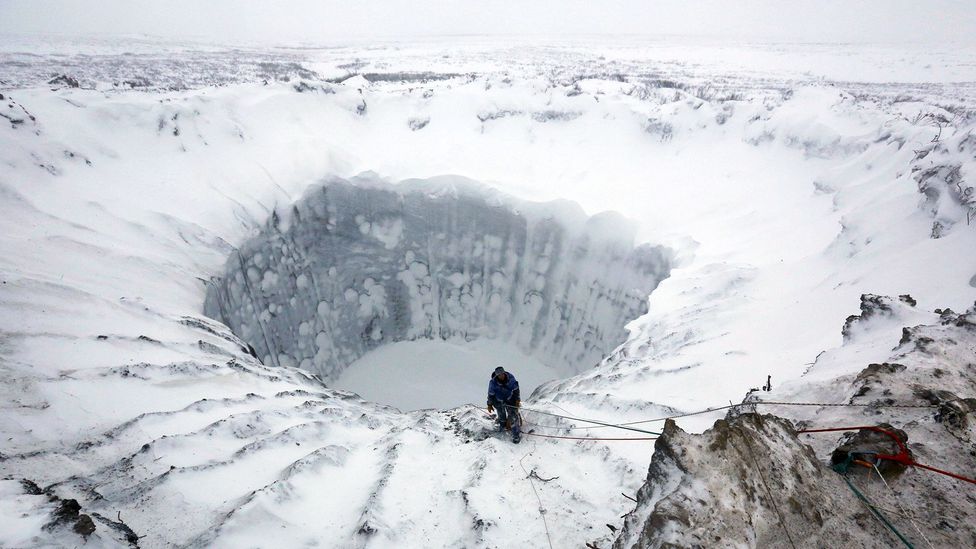
To understand more about how the craters form, scientists have lowered themselves into the deep holes to take samples (Credit: Sylvia Buchholz/Alamy)
Similar scars and mounds related to gas pocket emissions have been found on the floor of the Kara Sea, just off the Yamal Peninsula, and others have been found in the Barents Sea. But so far, says Natali, nothing similar has been found on land elsewhere in the Arctic.
Something about the permafrost in Yamal and Gydan makes them prone to these exploding mounds. “There are some characteristic features of the landscape there,” she says. “It is an area where there is a very thick layer of ice, called tabular ice, which forms a cap across the permafrost. It is also an area where there’s a lot of features known as cryopeg, which are areas of unfrozen ground surrounded by permafrost – a kind of permafrost sandwich. The third feature is very deep deposits of gas and oil.”
One crater recently examined by Chuvilin – a 66ft-wide (20m) hole known as the Erkuta crater after the river whose flood plain it appeared on – appears to have formed on the spot of a dried up oxbow lake. When the lake vanished, it left behind an unfrozen patch of soil beneath it known as a talik, where gas then built up. But Chauvilin says the exact source is still largely unclear. “The key issue in crater research is identifying the source of gas that builds up under the permafrost surface,” says Chuvilin. “Once the crater is there, the gas is already gone.”
Local reindeer herders reported seeing flames and smoke after one crater explosion in June 2017
Retracing the evolution of these mounds and how the gas gets there is now an intense source of study. “It is intriguing that there could be a new or previously unknown geochemical process happening that we would never have imagined,” says Natali.
Researchers brave enough to abseil down into the craters have found elevated levels of methane in the water pooling at the bottom, suggesting the gas may be bubbling up from below. One leading theory is that these deep deposits of methane gas under the permafrost find their way up to the unfrozen pocket of ground beneath the icy cap. Another idea is that high levels of carbon dioxide dissolved in the water in these unfrozen pockets begins to bubble out as the water starts to freeze, and the remaining water cannot hold onto the dissolved gas.
An alternative source of both methane and carbon dioxide could be microorganisms thriving in the unfrozen pocket of ground breaking down organic material and releasing the gases, says Chuvilin. Isotopic analysis of methane at one particularly dramatic crater appeared to confirm this, but the activity of methane-producing microbes, however, has been found to be particularly low in the lakes at the bottom of recently formed craters – even for the cold conditions where they are found.
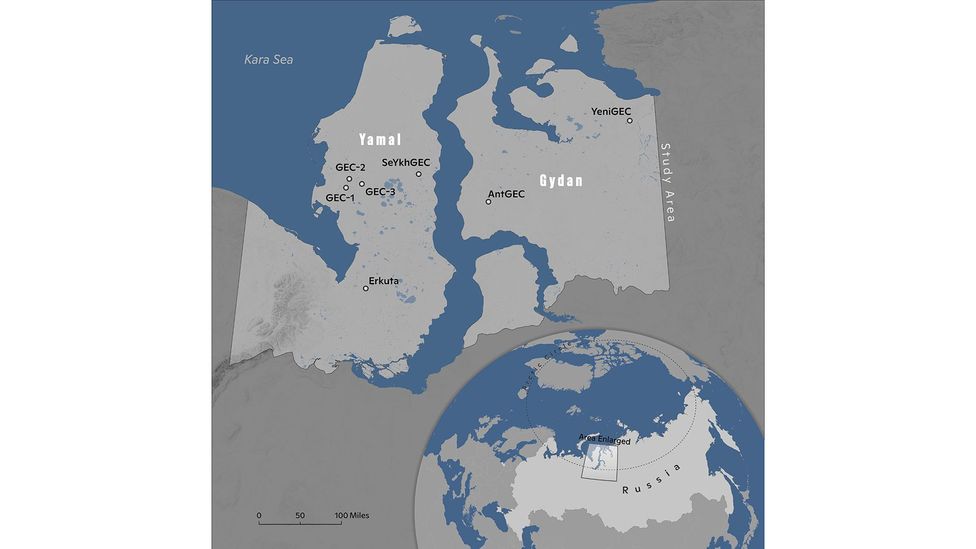
A number of craters have been found among the thermokarst lakes of Yamal and neighbouring Gydan Peninsulas – the locations of seven are shown on this map (Credit: Greg Fiske)
But methane could also be leaking out from the ice itself. Gases can become trapped inside the water crystals in permafrost to form a strange frozen material known as a gas hydrate. As it melts, the gas is liberated.
“It is thought that there may be different formation mechanisms which can hardly be described by a single model,” says Chuvilin. “Much depends on the environment and landscape.” At least one crater has been found in a riverbed, he points out.
Regardless of the source, it is thought that the gas builds up in the unfrozen pocket of ground, pushing the solid tabular ice cap upwards by 16-19ft (5-6m) until it ruptures like a boil. (While graphic, the furuncle analogy is not a bad one – much like internet users are fascinated by videos of pimple popping, so some scientists find themselves drawn to the Yamal craters. “It was the combination of the unknown and risk related to these craters that attracted me,” admits Natali.)
When they finally burst, they certainly appear to be spectacular. Mud and ice above the gas-filled pocket, along with much of the material in the unfrozen section itself, is flung outwards up to 980ft (300m) away. The force is so great that blocks of earth up to 3ft (1m) across are thrown outwards, leaving a crater with a raised parapet, a wide mouth and a narrower cylindrical hole – thought to be the unfrozen pocket – is left behind. Local reindeer herders reported seeing flames and smoke after one crater explosion in June 2017 along the banks of the Myudriyakha River. Villagers in nearby Seyakha – a settlement about 20.5 miles (33km) south of the crater – claimed the gas kept burning for about 90 minutes and the flames reached 13-16ft (4-5m) high.
Over a year or two the edges of the dark, angry wound erode and they fill with water
In this sparsely populated region of the world, for one to occur so close to a settlement has led to concern. The region is also splattered with pipelines for the oil and gas infrastructure trying to get at the fossil fuel deposits buried beneath the permafrost.
“We don’t yet know if these are something that could be a risk to people in the Arctic,” says Natali. She and her colleagues have been trying to answer this particular question by searching for signs of other craters in high resolution satellite images.
“Once we find something that looks like a crater, we are then using time series very high-resolution imagery [satellite pictures of the same location taken at different times] to try to work out when they formed,” she says. Their work seems to be suggesting that there are more craters out there than was previously believed. “We have so far confirmed and validated two new crater locations. Considering that back in 2013 we knew nothing about them, it seems very likely that there are more out there.”
Natali’s team went on to discover a third new crater, in results released in February 2021. They had identified a further 17 possible craters, but analysis of high resolution images led them to conclude they may not have formed from explosive gas emissions. “It’s hard to fully validate until we can be on the ground,” adds Natali. Their research has identified a number of other abrupt landscape changes in the region that had not been detected before related to the thawing of the permafrost. In total they spotted a 5% change in the landscape between 1984 and 2007.
Eventually Natali and her team hope to gather enough data to be able to automate the crater search process. Their aim is to create an algorithm that can predict craters before they form by looking out for likely gas emission mounds in satellite images.
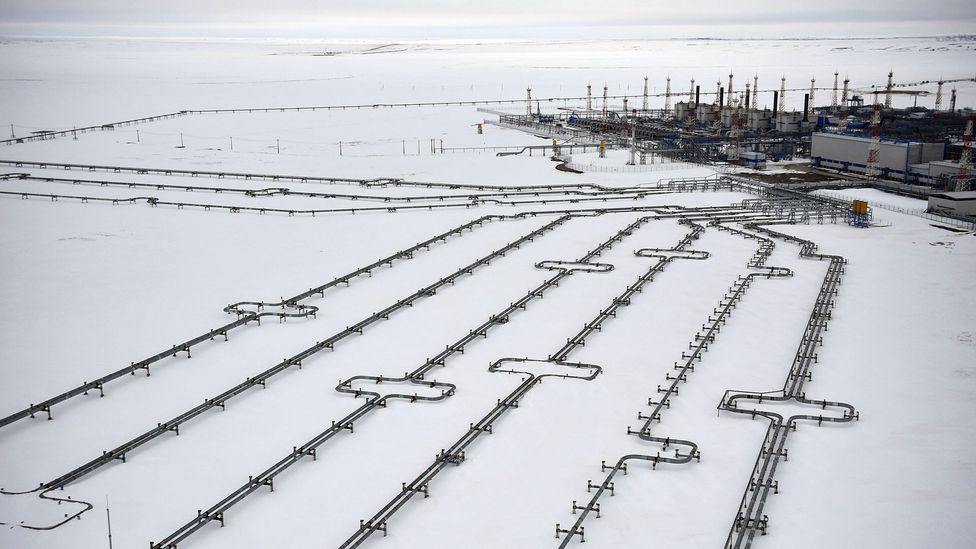
Gas and oil infrastructure dot the landscape in north-west Siberia – the Bovanenkovo gas field was just 26 miles from one of the craters (Credit: Alexander Nemenov/Getty Images)
“We hope to get to a point where we can see these before they form,” says Natali. “That is the sort of information you particularly want to know when these are happening in an area where there are people living, there are pipelines, and other gas and oil infrastructure.”
Unravelling exactly how common these craters are is currently a slow process. After their violent birth, most seem to disappear into the landscape almost as quickly – the void left by the explosion near Seyakha – which measured 70m (230ft) wide in places and more than 50m (164ft) deep – flooded with water in just four days due to its proximity to the river. This transition from hole to lake seems to be a rather innocuous end to a dramatic event.
Other craters take longer to flood, but over a year or two the edges of the dark, angry wound erode and they fill with water to become almost indistinguishable from the thousands of other small round lakes – known as thermokarst lakes – that dot the landscape. Exactly how many of these lakes are the scars of gas emission craters is still unclear.
“It is likely that some of the lakes in the permafrost are flooded gas emission craters,” says Kizyakov. “It is too early to say how common this is as a mechanism of lake formation.”
Some researchers have tried to identify former gas emission craters by measuring the chemicals dissolved in characteristic lakes, but have been unable to identify any patterns.
The craters are a very shocking indicator of what is happening in the Arctic more widely – Sue Natali
Finding out just how common these events are is driven by more than simple curiosity. There are growing concerns that the appearance of the craters in north-west Siberia might be related to wider changes taking place in the Arctic due to climate change.
Surface air temperatures in the Arctic are warming at twice the rate of the global average, which is increasing the amount of permafrost thaw during the summer months.
This in itself is transforming the Arctic landscape, leading to subsidence and landslides known as thaw slumps. Siberia boasts perhaps the largest thaw slump on the planet – the Batagaika megaslump, which has grown from being just a gully in the 1960s to being nearly 3,000ft (900m) wide. (Learn more about the megaslump that locals call “the gate to hell”.)
“There is nowhere else on the planet I know of that climate change is causing the physical structure of the ground to change,” says Natali.
Trapped inside the Arctic permafrost are huge amounts of carbon – about twice as much as the amount currently in the atmosphere. It is mostly in the form of the frozen remains of plants and other organic material, along with methane that has become trapped inside ice crystals – the gas hydrates that Chuvilin mentions earlier. As the ground thaws, it allows microorganisms to break down the organic matter, releasing methane and carbon dioxide as byproducts, while the methane trapped in the ice also breaks free.
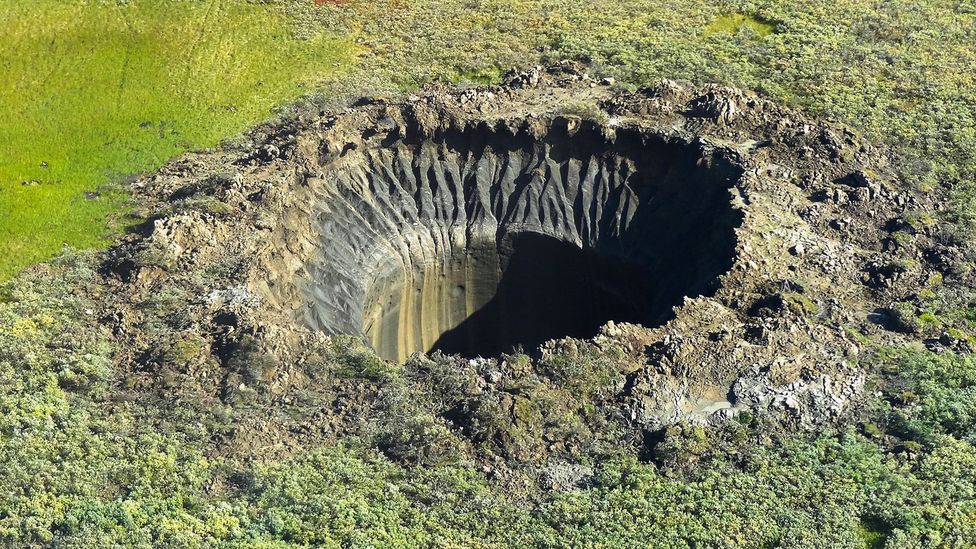
When they first appear, the craters are a spectacular sight as the explosion hurls out earth and ice to leave a deep cylindrical void (Credit: Vasily Bogoyavlensky/Getty Images)
As a potent greenhouse gas, this methane leaking out of permafrost has the potential to accelerate global warming and so drive even more melting.
But in Yamal, the craters have raised the prospect of another process that is adding even more uncertainty to the complex feedback loop between rising temperatures, permafrost thaw and the release of greenhouse gases. If it turns out that methane deposits trapped deep underground by the permafrost are starting to seep upwards through the normally impenetrable permafrost layers, it could be a sign that the frozen ice cap over the tundra is becoming more permeable. This could introduce new levels of uncertainty over how changes in the Arctic are likely to impact wider global warming on the planet.
“The craters are a very shocking indicator of what is happening in the Arctic more widely,” says Natali. “When you look at changes that are happening across this landscape, some are occurring gradually and others abruptly. Very few are occurring explosively, but it brings attention to how all these changes contribute to the greenhouse gases in the atmosphere.”
While the mystery of Yamal’s craters is still to be completely solved, what has been unravelled so far suggests that perhaps we should be watching them carefully in the future.








